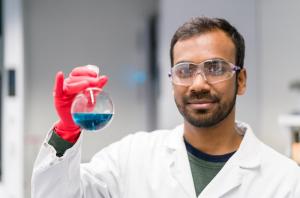TADF developer CYNORA has announced that it has extended its joint-development agreement with LG Display. The two companies have been co-developing deep-blue TADF OLED emitters for two years, and have now decided to continue the cooperation towards the commercialization of TADF emitters in OLED displays.

CYNORA's latest deep-blue material specification was presented in May 2018 - with a CIEy of 0.14, EQE of 20% and a lifetime of 20 hours LT97 at 700 nits. Cynora expects to have blue material in mass production by 2020. Cynora says that its TADF materials are suitable for both self-emitting or co-emitting approaches (which includes hyper-fluorescence).
Cynora also updated that while its focus is on deep-blue emitters for OLED TVs, it now also has plans to develop a sky-blue emitter for lighting applications. In 2017, Cynora said that after it'll finish developing a blue emitter it will start to develop red and green ones - but now Cynora announced that it has actually started to sample green TADF OLED emitter materials and has already shipped samples to OLED panel makers.
In August 2018 we interviewed Cynora's CMO Dr. Andreas Haldi - who talked about TADF, lifetime, color points and more.
Comments
Dear Anonymous,
I am sorry to see that you are so pessimistic about the TADF technology and the OLED industry in general.
Actually, the announcement that we have extended our JDA with LG Display is a big deal. It means that we were able to convince LGD of the potential of the TADF technology. When we started this JDA in 2016, it was unclear to most of us in the industry if TADF blue is really a solution for displays. But because of the good progress in the last two years, LGD sees the potential for commercialization so we were able to extend the JDA and they will also continue to put some resources into this joint work with CYNORA. After all, it is a joint development.
Whether quantum dots and microLEDs are on the rise, seems to depend on the perspective. Of course, we in the OLED industry see mostly the signs that OLEDs will still be the best solution, at least in mobile and TV applications. Many analysts seem to be of our opinion, too, but I am sure that you will find analysts with different opinions.
Regarding new results, we actually showed some new information in September at the OLEDs World Summit. We introduced that we are not only working on the self-emitting approach (sometimes also called classical approach) but also on the co-emitting approach (sometimes also called the hyper approach). In both cases, we showed the best results for the high-efficiency display blue (deep blue) that have been reported to date (including numbers).
Regarding green, it is true, we have started to sample first materials. This is in line with our strategy that we had communicated in the last two years. We first worked on the most challenging material, display blue (deep blue), and once we had good results there, we started with green. Later, we will also do red. The idea behind it was that our blue knowhow will help us with the green and red development. And it turns out that our first green materials actually do show a surprisingly good performance. I would love to give you actual data about green here but unfortunately, I am not allowed to show any values yet.
If this information does not convince you, you are always welcome to contact us directly by email, phone or through our website. We are happy to discuss the TADF technology or the OLED industry with you.
Best regards,
Andreas Haldi


So the only actual news it that LG, one of their investors, is NOT going to drop them? Big whoop. Would be more interesting to read who is going to finance them from now to 2020 (I thought they wanted to reach this stage in 2017 already). Most of the money they raised last year should be gone by now if their reported head count is true. With quantum dots and MicroLED on the rise, this is just not an interesting business case anymore.
Feels that all they do is stalling for time. In the linked interview, Haldi promised new performance numbers by August. No update likely means that the breakthrough they were counting on still did not happen. Pity.
Also, as Ron pointed out, they changed their story. In August, Haldi was half-moking Kyulux for doing sky-blue and green and earning honest revenues with PMOLED and now they do it themselves colorwise, even though it is clear that OLED lightning is not going to bring substantial sales. Plus sending out samples to panel makers is hardly a milestone, anybody can do it. Where are the numbers?